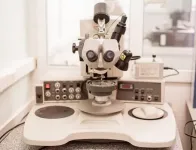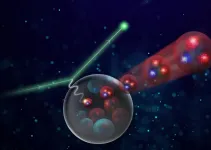(Press-News.org) When a muscle grows, because its owner is still growing too or has started exercising regularly, some of the stem cells in this muscle develop into new muscle cells. The same thing happens when an injured muscle starts to heal. At the same time, however, the muscle stem cells must produce further stem cells - i.e., renew themselves - as their supply would otherwise be depleted very quickly. This requires that the cells involved in muscle growth communicate with each other.
Muscle growth is regulated by the Notch signaling pathway
Two years ago, a team of researchers led by Professor Carmen Birchmeier, head of the Developmental Biology/Signal Transduction Lab at the Berlin-based Max Delbrück Center for Molecular Medicine in the Helmholtz Association (MDC), showed that the development of stem cells into muscle cells is regulated with the help of two proteins, Hes1 and MyoD, which are produced in the progenitor cells in an oscillatory manner - i.e., there are periodic fluctuations in the number of cells produced.
Both proteins are involved in the Notch signaling pathway, a widespread mechanism by which cells respond to external stimuli and communicate with other cells. The signaling pathway is named after its receptor "Notch," onto which the ligand "Delta," a cell surface protein, latches.
A third protein, Delta-like1, plays a crucial role
"In our current study, we have provided unequivocal evidence that oscillation in muscle tissue is not just some strange phenomenon of the cells involved, but that these rhythmic fluctuations in gene expression are actually crucial for transforming stem cells into muscle cells in a balanced and controlled manner," says Birchmeier.
Together with researchers from Japan and France, Birchmeier and four other scientists at the MDC also uncovered the crucial role of a third protein that, along with Hes1 and MyoD, forms a dynamic network within the cells. As the team reports in the journal Nature Communications, this protein is the Notch ligand Delta-like1, or Dll1 for short. "It is produced in activated muscle stem cells in a periodically fluctuating manner, with the oscillation period lasting two to three hours," Birchmeier explains, adding: "Whenever a portion of the stem cells expresses more Dll1, the amount in the other cells is correspondingly lower. This rhythmic signaling determines whether a stem cell becomes a new stem cell or develops into a muscle cell."
The Hes1 protein sets the pace in the stem cells
In their experiments with isolated stem cells, individual muscle fibers and mice, Birchmeier and her team further investigated how the Hes1 and MyoD proteins are involved in muscle growth. "Put simply, Hes1 acts as the oscillatory pacemaker, while MyoD increases Dll1 expression," says Dr. Ines Lahmann, a scientist in Birchmeier's lab and a lead author of the study along with Yao Zhang from the same team. "These findings were demonstrated not only in our experimental analyses, but also in the mathematical models created by Professor Jana Wolf and Dr. Katharina Baum at the MDC," Birchmeier says.
Experiments with mutant mice provided the decisive proof
With the help of gene-modified mice, the researchers obtained the most important evidence that Dll1 oscillation plays a critical role in regulating the transformation of stem cells into muscle cells. "In these animals, a specific mutation in the Dll1 gene causes production of the protein to occur with a time delay of a few minutes," Birchmeier explains. "This disrupts the oscillatory production of Dll1 in cell communities, but does not alter the overall amount of the ligand."
"Nevertheless, the mutation has severe consequences on the stem cells, propelling them to prematurely differentiate into muscle cells and fibers," reports Zhang, who performed a large portion of the experiments. As a result, he says, the stem cells were depleted very quickly, which resulted, among other things, in an injured muscle in the mice's hind legs regenerating poorly and remaining smaller than it had been before the injury. "Quite obviously, this minimal genetic change manages to disrupt the successful communication - in the form of oscillation - between stem cells," Zhang says.
This knowledge could lead to better treatments for muscle diseases
"Only when Dll1 binds to the Notch receptor in an oscillatory manner and thus periodically initiates the signaling cascade in the stem cells is there a good equilibrium between self-renewal and differentiation in the cells," Birchmeier concludes. The MDC researcher hopes that a better understanding of muscle regeneration and growth may one day help create more effective treatments for muscle injuries and diseases.
INFORMATION:
The Max Delbrück Center for Molecular Medicine (MDC)
The Max Delbrück Center for Molecular Medicine in the Helmholtz Association (MDC) was founded in Berlin in 1992. It is named for the German-American physicist Max Delbrück, who was awarded the 1969 Nobel Prize in Physiology and Medicine. The MDC's mission is to study molecular mechanisms in order to understand the origins of disease and thus be able to diagnose, prevent and fight it better and more effectively. In these efforts the MDC cooperates with the Charité - Universitätsmedizin Berlin and the Berlin Institute of Health (BIH) as well as with national partners such as the German Center for Cardiovascular Research and numerous international research institutions. More than 1,600 staff and guests from nearly 60 countries work at the MDC, just under 1,300 of them in scientific research. The MDC is funded by the German Federal Ministry of Education and Research (90 percent) and the State of Berlin (10 percent), and is a member of the Helmholtz Association of German Research Centers. http://www.mdc-berlin.de
A new study shows that a widespread decline in abundance of emergent insects - whose immature stages develop in lakes and streams while the adults live on land - can help to explain the alarming decline in abundance and diversity of aerial insectivorous birds (i.e. preying on flying insects) across the USA. In turn, the decline in emergent insects appears to be driven by human disturbance and pollution of water bodies, especially in streams. This study, published in END ...
Who would have thought that a small basic compound like vitamin B6 in the banana or fish you had this morning may be key to your body's robust response against COVID-19?
Studies have so far explored the benefits of vitamins D and C and minerals like zinc and magnesium in fortifying immune response against COVID-19. But research on vitamin B6 has been mostly missing. Food scientist END ...
HDL cholesterol (high-density lipoprotein cholesterol) or good cholesterol is associated with a decreased risk of cardiovascular disease as it transports cholesterol deposited in the arteries to the liver to be eliminated. This contrasts with the so-called bad cholesterol, LDL (low-density lipoprotein cholesterol), which causes cholesterol to accumulate in the arteries and increases cardiovascular risk. Although drugs that lower bad cholesterol reduce cardiovascular risk, those that raise good cholesterol have not proven effective in reducing the risk of heart disease. This paradox has called into question the ...
Whilst the nation has taken to washing its hands regularly since the start of the pandemic, other individual behaviours, such as cleaning and disinfecting surfaces or social distancing within the home, have proved harder to stick, say the researchers behind the behaviour change website 'Germ Defence'.
In their new study, published today (Friday 26 February 2021) in the Journal of Medical Internet Research, psychologists from the universities of Bath, Bristol and Southampton, warn of the continuing risks of household transmission of COVID-19 and the ongoing importance of breaking chains of transmission now and in the future.
Their research analysed user data of the ...
Treating critically ill COVID-19 patients with drugs typically used for rheumatoid arthritis may significantly improve survival, a landmark study has found.
The findings, which were announced in January and have now been peer-reviewed and published in the New England Journal of Medicine, come from the REMAP-CAP trial, which evaluates the effect of treatments on a combination of survival and length of time patients need support in an intensive care unit (ICU).
Initial findings reported in November showed that tocilizumab, a drug used to treat arthritis, was likely to improve outcomes among critically ill COVID-19 ...
Clinical research requires that data be mined for insights. Machine learning, which develops algorithms to find patterns, has difficulty doing this with data related to health records because this type of information is neither static nor regularly collected. A new study developed a transparent and reproducible machine learning tool to facilitate analysis of health information. The tool can be used in clinical forecasting, which can predict trends as well as outcomes in individual patients.
The study, by a researcher at Carnegie Mellon University (CMU), appears in Proceedings of Machine Learning Research.
"Temporal Learning Lite, or TL-Lite, is a visualization and forecasting tool to ...
Physicists from Russia, Chile, Brazil, Spain, and the UK, have studied how the magnetic properties change in 3D nanowires, promising materials for various magnetic applications, depending on the shape of their cross-section. Particularly, they more deeply probed into the Walker breakdown phenomenon, on the understanding of which the success of the implementation of the future electronics devices depends. The research outcome appears in Scientific Reports.
The cross-sectional geometry of a three-dimensional nanowire affects the domain wall dynamics and therefore is crucial for their control. In turn, managing the DW dynamics under various external conditions is necessary in order to realize the future electronics and computing devices, operating on new physical principles. ...
Born in food web ecology, the concept of trophic levels -- the hierarchy of who eats who in the natural world -- is an elegant way to understand how biomass and energy move through a natural system. It's only natural that the idea found its way into the realm of aquaculture, where marine and freshwater farmers try to maximize their product with efficient inputs.
"It's often used as a measure of how sustainable it is to harvest or consume that species," said Rich Cottrell(link is external), a postdoctoral researcher at UC Santa Barbara's National Center for Ecological Analysis & Synthesis (NCEAS). As plants (level 1) become food to plant eaters (level 2), who in turn are consumed by carnivores (level 3) and so on, the amount of energy ...
Hypertrophic cardiomyopathy (HCM) is a cardiovascular disease characterized by thickening of the left ventricle, otherwise known as the main squeezing chamber of the heart. HCM is best known for causing sudden death in athletes but can occur in persons of any age, often without symptoms. While frequently discussed in the context of genetics, most patients with HCM do not have a known genetic variant. Investigators from Brigham and Women's Hospital uncovered a means to study the complexity of this disease beyond the identification of individual genes. This new approach offers a path toward treating HCM using individualized medicine. ...
While protons populate the nucleus of every atom in the universe, sometimes they can be squeezed into a smaller size and slip out of the nucleus for a romp on their own. Observing these squeezed protons may offer unique insights into the particles that build our universe.
Now, researchers hunting for these squeezed protons at the U.S. Department of Energy's Thomas Jefferson National Accelerator Facility have come up empty handed, suggesting there's more to the phenomenon than first thought. The result was recently published in Physical Review Letters.
"We were looking to squeeze the proton such that its quarks are in a small-size configuration. And that's a pretty tough ...


